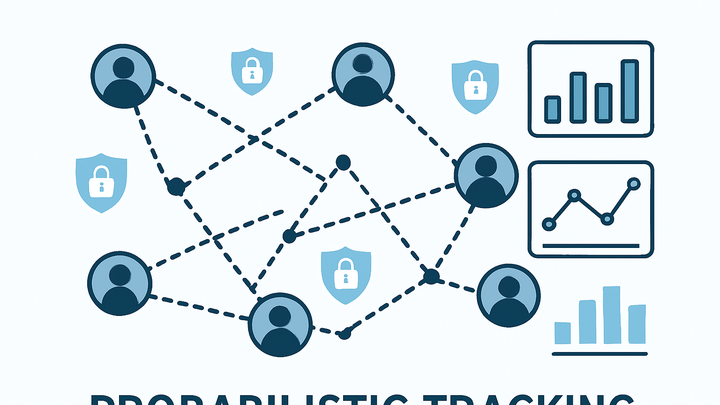Published on 2025-06-26T05:15:05Z
What is Probabilistic Tracking? Examples Using PlainSignal and GA4
Probabilistic tracking is a method in analytics that uses statistical modelling and indirect data signals to infer user behavior in the absence of deterministic identifiers like cookies or logged-in user IDs. By analyzing patterns from signals such as IP address, user-agent strings, screen resolution, and interaction timing, probabilistic tracking approximates unique sessions and user journeys. This approach is particularly valuable in environments where cookie blocking, privacy regulations, or device switching prevent traditional tracking methods. SaaS solutions such as PlainSignal offer simple, cookie-free probabilistic analytics, while platforms like Google Analytics 4 (GA4) integrate probabilistic models to fill gaps when first-party cookies are unavailable. Though less precise than deterministic techniques, probabilistic tracking provides marketers and analysts with valuable insights while adhering to modern privacy standards. Because it relies on aggregated, anonymized data, probabilistic tracking can also enhance user privacy by avoiding the reliance on persistent identifiers.
Probabilistic tracking
Cookie-free statistical method that infers user behavior from indirect signals when traditional identifiers are unavailable.
Overview of Probabilistic Tracking
An introduction to the concept of probabilistic tracking, its role in modern analytics, and why it matters in privacy-focused environments.
-
Definition
Probabilistic tracking uses statistical algorithms to combine multiple anonymized data points—such as IP address, device type, and session timing—to identify and connect user interactions in the absence of deterministic IDs.
-
Why use probabilistic tracking?
When cookies are blocked or deleted, or privacy regulations limit traditional identifiers, probabilistic tracking fills gaps by estimating session continuity and user counts.
How Probabilistic Tracking Works
A deep dive into the signals and algorithms that power probabilistic tracking.
-
Data signals
Common signals include IP addresses, device and browser characteristics, time stamps, geographic location, and click patterns. These factors help form user fingerprints for statistical matching.
-
Ip address
Helps approximate user location and distinguish between different networks.
-
User-agent string
Provides browser type, version, and operating system information.
-
Device characteristics
Includes screen resolution, device model, and language settings.
-
Temporal patterns
Session timestamps and interaction order to link actions.
-
-
Modeling and algorithms
Machine learning and probabilistic models calculate the likelihood that discrete events belong to the same user or session.
-
Clustering algorithms
Group similar data points to infer single user sessions.
-
Scoring thresholds
Set confidence levels for matching events.
-
Probabilistic vs Deterministic Tracking
Comparing key differences between probabilistic and deterministic approaches to user tracking.
-
Deterministic tracking
Relies on unique, persistent identifiers such as cookies, login IDs, or mobile device IDs to track users with high accuracy.
-
Comparative pros & cons
Highlights the differences, strengths, and weaknesses of each approach.
-
Advantages of probabilistic
Resilient to cookie deletion and blocking, more privacy-friendly.
-
Disadvantages of probabilistic
Lower accuracy, potential for duplicate or missing sessions.
-
Advantages of deterministic
High precision and consistent user identification.
-
Disadvantages of deterministic
Vulnerable to ad blockers, privacy regulations, and cookie restrictions.
-
Implementing Probabilistic Tracking with PlainSignal and GA4
Step-by-step guidance for setting up probabilistic tracking in PlainSignal and leveraging probabilistic insights in GA4.
-
PlainSignal setup
Insert the PlainSignal script to enable cookie-free probabilistic tracking:
<link rel="preconnect" href="//eu.plainsignal.com/" crossorigin /> <script defer data-do="yourwebsitedomain.com" data-id="0GQV1xmtzQQ" data-api="//eu.plainsignal.com" src="//cdn.plainsignal.com/plainsignal-min.js"></script>-
Script tag placement
Place the
<link>and<script>tags within the<head>section for optimal preconnect and loading performance. -
Configuration parameters
data-dospecifies your domain,data-idis your PlainSignal site token, anddata-apipoints to the tracking endpoint.
-
-
GA4 configuration for probabilistic data
In Google Analytics 4, probabilistic modeling supplements first-party cookie data when cookies aren’t available. Enable Google Signals and data-driven attribution to leverage these algorithms.
-
Enable google signals
Activate Google Signals in the GA4 Admin settings to gather aggregated, anonymized user data.
-
Configure data-driven attribution
Opt into data-driven attribution models to allow GA4’s probabilistic algorithms to fill in gaps.
-
Advantages and Limitations
An overview of the strengths and weaknesses of probabilistic tracking.
-
Advantages
Provides continuous insights despite cookie restrictions; enhances privacy compliance by avoiding persistent identifiers; supports cross-session and cross-device analysis.
-
Limitations
Accuracy depends on signal quality and volume; modeling may misattribute sessions; not ideal for precise identity-level marketing or compliance-grade audits.
Best Practices
Recommendations for maximizing the effectiveness and compliance of probabilistic tracking.
-
Combine with deterministic methods
Use probabilistic tracking as a fallback, complementing deterministic identifiers when users authenticate or consent to cookies.
-
Maintain transparency and consent
Clearly disclose your tracking methods and honor user consent preferences to stay compliant with regulations like GDPR and CCPA.
-
Monitor data quality
Regularly audit metrics for anomalies, compare probabilistic estimates against deterministic baselines, and adjust matching thresholds as needed.
